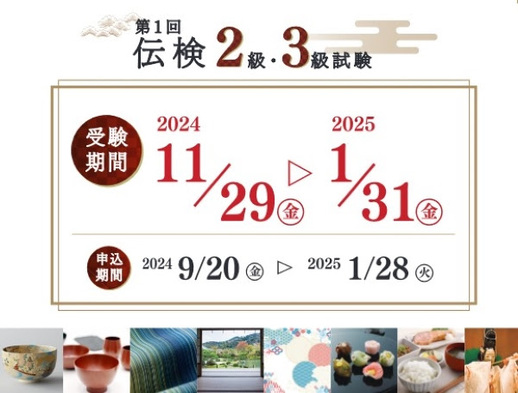2024.11.28
伝検通信(メルマガ)週刊メールマガジン「伝検通信」 臨時増刊号(第34号)
週刊メールマガジン「伝検通信」臨時増刊号(第34号)をお届けします。
試験まであと1週間となりました。検定直前の学習ポイントについてお知らせします。
伝検2級および3級の第1回受験は下記URLからお申込みください。公式テキスト、2級受験者向けオンライン講座の販売もスタートしています。ぜひお申し込みください。
伝検申込サイト https://denken-test.jp/
【検定直前の学習ポイント】

伝検第1回試験がいよいよ11月29日(金)から始まります。試験直前ということで協会から学習ポイントを紹介します。伝検は”「和」を知る・「和」を楽しむ・「和」を伝える”がテーマの検定です。問題には3級、2級とも画像も取り入れています。伝統文化を知ることで鑑賞が楽しくなったり、人に教えたくなったりする知識は試験でも問われます。
3級はテキストから90%が出題されます。60分で80問中56問正解すれば合格です。テキストで赤い太字の重要用語を確認するとともに紛らわしい技法や作品名などは特徴と違いをまとめておくとよいと思います。伝統工芸は産地とひも付けして理解することも大切です。残りのテキスト外の10%は日々の生活でなじみ深い伝統文化に関するものや伝検クイズで扱ったものがほとんどなので、まずはテキストの内容をしっかりと押さえましょう。
【3級例題(金工・木漆工)】
漆を使わない木工技法で白木の素地に胡粉で絵柄を盛り上げて形づくるものは、次のうちどれでしょう。
①象嵌
②彫嵌
③存清
④置上
答えは④
2級は70%がテキストから出題されます。90分で100問中70問正解、かつ8分野の各正解率が50%以上で合格です。出題内容はただ重要用語を覚えておけば、正解できる問題ばかりではありません。重要用語と関連用語を正しく把握する必要があります。また、理由を問うような問題も多いのでしっかりと背景を含めて理解しておきましょう。30%のテキスト外問題は伝検クイズのアーカイブをチェックするとともに、テキストを読んで疑問に思ったことを自分でも追加で調べて深堀りしておきましょう。
【2級例題(日本茶)】
鎌倉時代には貴族や武士の間で闘茶という飲み当てを競う賭け事が流行しました。闘茶の内容は、次のうちどれでしょう?
①本山茶かそれ以外かを当てる
②栂尾産かそれ以外かを当てる
③玉露かそれ以外かを当てる
④碾茶かそれ以外かを当てる
答えは②
受験者のみなさまの合格をご祈念しております。
【English version】
Weekly e-mail magazine “DENKEN TSUSHIN” Extra Issue (No. 34)
We are pleased to present an extra issue of our weekly e-mail newsletter “DENKEN TSUSHIN”.
There is only one week left until the examination. We would like to inform you about the study points just before the examination.
Please register for the first exam for DENKEN Level 2 and Level 3 at the URL below. The official textbook and the online course for Level 2 test takers are now on sale. Please apply for it.
Denken application website: https://denken-test.jp/examination/

Study points just before the examination
The first DENKEN examination will finally begin on Friday, November 29. As it is just before the exam, the association would like to introduce some study points. The theme of the DENKEN test is “to know ‘wa’, enjoy ‘wa’, and convey ‘wa’. The questions for both Level 3 and Level 2 include images. Knowledge of traditional culture makes appreciation of it more enjoyable and makes you want to teach it to others, which is also tested in the exam.
The third level consists of 90% of questions from the textbook, and you will be required to answer 56 out of 80 questions correctly in 60 minutes to pass the exam. It is recommended that you review the important terms in bold red type in the textbook and summarize the characteristics and differences of confusing techniques and names of works. It is also important to understand traditional crafts by linking them to their places of origin. The remaining 10% of the course outside of the text is mostly about traditional culture that is familiar to us in our daily lives, and about the topics covered in the DENKEN quiz, so first make sure you have a good grasp of the contents of the text.
Example of Level 3 (metal and wood lacquer work)
Which of the following is a woodworking technique that does not use lacquer, in which a pattern is formed by heaping up a white wooden base with shell white powder?
(1) ZOGAN
(2) CHOGAN
(3) ZONSEI
(4) OKIAGE
The answer is (4)
The Level 2 exam consists of 70% of questions from the textbook, and a student must answer 70 out of 100 questions correctly in 90 minutes, with a minimum of 50% correct in each of the 8 areas to pass the exam. Not all questions can be answered by simply memorizing important terms. It is necessary to correctly grasp the key terms and related terms. Also, many of the questions ask for reasons, so make sure you understand the background of the question. 30% of the questions are outside of the text, so check the DENKEN quiz archives and do additional research on your own to dig deeper into the questions you have read in the text.
Example of Level 2 (Japanese Tea)
In the Kamakura period (1185-1333), a betting game called “tea fighting” became popular among aristocrats and warriors to see who could win a cup of tea. Which of the following describes the content of tea fighting?
(1) Guess whether it is Honyamacha or not.
(2) Guess whether it is from toganoo or not
(3) Guess whether it is Gyokuro or not
(4) Guess whether it is Tencha or not
The answer is (2)
We wish all examinees success in their examinations.
カテゴリー: 伝検通信(メルマガ)





